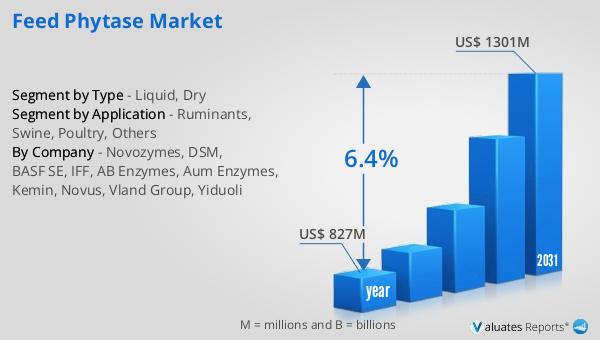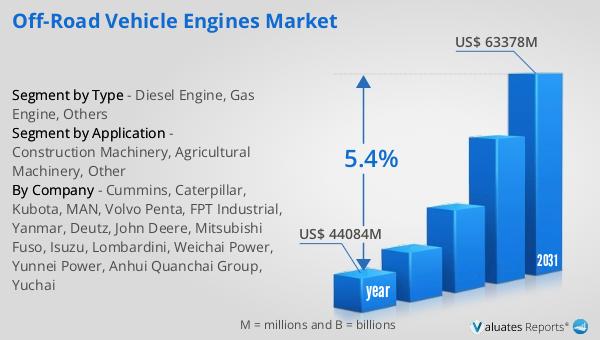What is Global Feed Phytase Market?
The Global Feed Phytase Market is a specialized segment within the animal feed industry, focusing on the production and distribution of phytase enzymes. Phytase is an enzyme that breaks down phytic acid, a form of phosphorus that is not readily digestible by animals. By adding phytase to animal feed, producers can enhance the nutritional value of the feed, allowing animals to better absorb phosphorus and other essential nutrients. This not only improves animal growth and health but also reduces the environmental impact of animal waste, as less undigested phosphorus is excreted. The market for feed phytase is driven by the increasing demand for high-quality animal protein, the need for sustainable agricultural practices, and regulatory pressures to reduce phosphorus pollution. As the global population continues to grow, the demand for efficient and sustainable animal farming practices is expected to rise, further propelling the growth of the feed phytase market. The market is characterized by a range of products, including liquid and dry formulations, catering to different types of livestock such as poultry, swine, and ruminants. Companies operating in this market are continually innovating to improve enzyme efficacy and stability, ensuring that their products meet the evolving needs of the animal feed industry.

Liquid, Dry in the Global Feed Phytase Market:
In the Global Feed Phytase Market, products are primarily available in two forms: liquid and dry. Each form has its own set of advantages and applications, catering to the diverse needs of the animal feed industry. Liquid phytase is often preferred for its ease of mixing and uniform distribution in feed formulations. It is particularly beneficial in large-scale feed production facilities where automated systems can precisely control the dosage and ensure consistent application. Liquid phytase is also advantageous in terms of its rapid action, as it can quickly integrate with the feed components, enhancing the bioavailability of phosphorus and other nutrients. However, liquid formulations may require specific storage conditions to maintain enzyme stability, which can be a consideration for producers. On the other hand, dry phytase is favored for its stability and longer shelf life. It is typically available in granular or powder form, making it easy to handle and store. Dry phytase is often used in smaller feed operations or in regions where storage conditions may not be optimal for liquid formulations. The dry form is also advantageous in terms of transportation, as it is less prone to spillage and degradation during transit. Additionally, dry phytase can be easily incorporated into premixes or directly into feed, providing flexibility for feed manufacturers. Both liquid and dry phytase play a crucial role in enhancing the nutritional profile of animal feed. By breaking down phytic acid, these enzymes release bound phosphorus, making it available for absorption by animals. This not only improves animal growth and productivity but also reduces the need for inorganic phosphorus supplements, leading to cost savings for producers. Furthermore, the use of phytase contributes to environmental sustainability by minimizing phosphorus excretion in animal waste, thereby reducing the risk of water pollution. The choice between liquid and dry phytase often depends on several factors, including the type of livestock being fed, the scale of feed production, and the specific requirements of the feed formulation. For instance, poultry and swine producers may prefer liquid phytase for its rapid action and ease of integration into feed, while ruminant producers might opt for dry phytase due to its stability and compatibility with various feed ingredients. In recent years, advancements in enzyme technology have led to the development of more robust and efficient phytase products. Manufacturers are focusing on improving the thermal stability and pH tolerance of phytase enzymes, ensuring that they remain active throughout the feed processing and digestion stages. This has expanded the applicability of phytase across different feed types and production environments. Overall, the availability of both liquid and dry phytase in the Global Feed Phytase Market provides feed manufacturers with the flexibility to choose the most suitable form for their specific needs. As the demand for sustainable and efficient animal farming practices continues to grow, the role of phytase in enhancing feed quality and reducing environmental impact is expected to become increasingly important.
Ruminants, Swine, Poultry, Others in the Global Feed Phytase Market:
The Global Feed Phytase Market finds extensive application across various livestock categories, including ruminants, swine, poultry, and others. Each category presents unique nutritional challenges and opportunities for the use of phytase to enhance feed efficiency and animal health. In ruminants, such as cattle and sheep, phytase is used to improve the digestibility of phosphorus and other nutrients in feed. Ruminants have a complex digestive system that can partially break down phytic acid, but the addition of phytase can further enhance nutrient absorption. This is particularly important in dairy cattle, where optimal phosphorus levels are crucial for milk production and overall health. By improving phosphorus utilization, phytase helps reduce feed costs and minimizes the environmental impact of phosphorus excretion. In swine production, phytase is a critical component of feed formulations. Swine have a limited ability to digest phytic acid, making them highly dependent on supplemental phosphorus sources. By incorporating phytase into swine diets, producers can significantly improve phosphorus availability, leading to better growth rates and feed conversion efficiency. This not only enhances the profitability of swine operations but also contributes to environmental sustainability by reducing phosphorus runoff from manure. The use of phytase in swine feed is particularly beneficial in regions with stringent environmental regulations, where reducing phosphorus pollution is a priority. Poultry, including chickens and turkeys, also benefit greatly from the inclusion of phytase in their diets. Poultry have a relatively simple digestive system and are unable to effectively utilize phytic acid-bound phosphorus. As a result, phytase is widely used in poultry feed to enhance phosphorus digestibility and improve overall nutrient absorption. This leads to healthier birds with better growth performance and egg production. Additionally, the use of phytase in poultry feed helps reduce the need for inorganic phosphorus supplements, lowering feed costs and minimizing the environmental impact of poultry farming. Beyond ruminants, swine, and poultry, phytase is also used in other livestock categories, such as aquaculture and companion animals. In aquaculture, phytase is added to fish and shrimp feed to improve phosphorus utilization and reduce water pollution from aquaculture operations. Similarly, in companion animals like dogs and cats, phytase can be used to enhance the nutritional value of pet food, promoting better health and well-being. Overall, the use of phytase in the Global Feed Phytase Market is driven by the need to improve feed efficiency, reduce costs, and minimize environmental impact across various livestock categories. As the demand for high-quality animal protein continues to rise, the role of phytase in optimizing feed formulations and supporting sustainable animal farming practices is expected to grow.
Global Feed Phytase Market Outlook:
In 2024, the global market for Feed Phytase was valued at approximately 827 million US dollars. This market is anticipated to expand significantly, reaching an estimated size of 1301 million US dollars by the year 2031. This growth trajectory represents a compound annual growth rate (CAGR) of 6.4% over the forecast period. The increasing demand for feed phytase is driven by the need for more efficient and sustainable animal farming practices. As the global population continues to grow, there is a rising demand for high-quality animal protein, which in turn fuels the need for effective feed additives like phytase. By enhancing the digestibility of phosphorus and other nutrients in animal feed, phytase not only improves animal growth and health but also reduces the environmental impact of animal waste. This dual benefit makes phytase an attractive option for feed manufacturers and livestock producers worldwide. The projected growth of the feed phytase market reflects the ongoing efforts to optimize animal nutrition and promote sustainable agricultural practices. As the market continues to evolve, companies are likely to focus on developing more advanced and efficient phytase products to meet the diverse needs of the animal feed industry.
| Report Metric | Details |
| Report Name | Feed Phytase Market |
| Accounted market size in year | US$ 827 million |
| Forecasted market size in 2031 | US$ 1301 million |
| CAGR | 6.4% |
| Base Year | year |
| Forecasted years | 2025 - 2031 |
| Segment by Type |
|
| Segment by Application |
|
| Production by Region |
|
| Consumption by Region |
|
| By Company | Novozymes, DSM, BASF SE, IFF, AB Enzymes, Aum Enzymes, Kemin, Novus, Vland Group, Yiduoli |
| Forecast units | USD million in value |
| Report coverage | Revenue and volume forecast, company share, competitive landscape, growth factors and trends |
